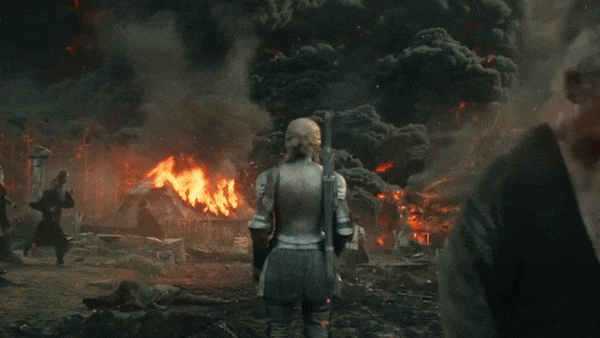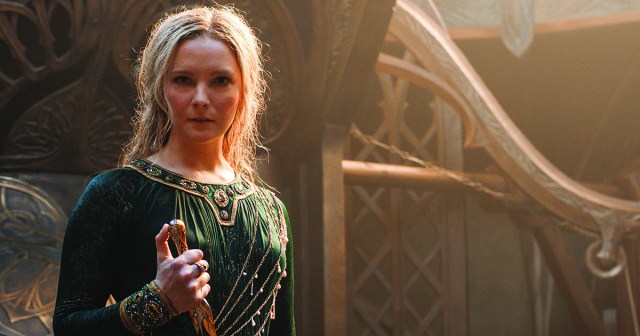
TL;DR
- Season one of “The Rings of Power” is available on Amazon Prime. Season two filming began in October 2022.
Amazon Studios’ “Lord of the Rings: The Rings of Power,” is a fantasy series based on JRR Tolkien’s ‟Silmarillion” and other Lord of the Rings mythology texts.
For episode six and seven director Charlotte Brändström, that meant they couldn’t rely on sci-fi tropes to accomplish any natural phenomena in Middle Earth. This world might have magic, but physics applies to it, as well.
This was especially important because these episodes feature the explosion of Mount Doom and then devastating aftermath in the Southlands.
“[I]t was all based on reality. Now, we believe that the depiction of magic, or supernatural events are descriptions of science that we don’t fully understand. It’s bent physics,” producer Ron Ames told Variety’s Making a Scene. “So we wanted to make sure that the audience is swept with the reality of it. And that it is powerful as can be.”
Additionally, director Charlotte Brändström knew that both episodes — which she said were more like a feature film than standard TV — needed to be anchored by Galadriel’s viewpoint. “Whenever I get a script or a scene, I look at perspective,” Brändström told Variety. “That’s really important because it gives a point of view for the audience to identify with; you had to become Galadriel’s point of view because she’s sort of the thread throughout.”
Watch ‟Rings of Power” creators break down the Mount Doom machine for Variety’s Making a Scene series.
So how, exactly, did they pull it off? For starters, some good, old-fashioned (television) magic.
Ames admits it was daunting. “This is like making [special effects] for feature films. It was huge. This was one of the key moments that we knew we were going to be building the first challenge and creating an event that is included in nature.”
PLANNING AND LOTS OF RESEARCH
First and foremost, they had to create Mount Doom, pre-eruption.
“How are we going to actually, physically, make this believable and not look like a cartoon?” Ames says he wondered. This was additionally complicated because “we knew that people have a vision of what” this mountain looks like. To stay true to that, he says, they “wanted to actually take what [other creators] had done, and then make a very clear interpretation in our world.”
That meant, Ames says, “we went immediately to research, and we started looking at descriptions of Pompeii, Mount St. Helens, so we were very respectful of Tolkien’s descriptions, his drawings, the sharp peak in nature of the mountain itself. We were also inspired by Peter Jackson, his work and what had come before.”
Once the mountain design was hammered out, they had to determine the tone and the context for the eruption.
“It was important for us to create this environment that felt sunny, felt warm, colorful, to then make the horror of what is happening,” cinematographer Alex Disendorf told Variety.
After all, Brändström says, “Film [is] always about contrast. You want to destroy a beautiful world; you want to damage something that’s beautiful. So you wanted everything to be lush and beautiful. They were cheering and drinking and laughing and enjoying themselves, when suddenly everything around them started falling apart.”
But, again, the team wanted the audience to understand and anticipate what was happening before Galadriel and the other characters would have any idea what was coming.
“We needed to understand that there was this key that we had been teasing throughout season one, a broken sword. And by putting it in this stone and turning it, it would essentially unlock the dams that would then allow the water to flow underground into these tunnels that… we’ve seen the orcs digging these tunnels. We haven’t known what they were for, you know, allowing the water to flow through under the village, [eventually] hitting the magma and lava in the mountain and causing the explosion,” Ames says, emphasizing that the whole sequence was based on a practical machine design as well as the science that would actually set off such a reaction.

From “The Lord of the Rings: The Rings of Power,” Cr: Amazon Studios
The waterworks, they decided, was “basically a dam that had been built in and disguised into the side of the mountain” to look like a small waterfall. Ames says, “that actually is photography of a real body of water.” But the final scene itself features work done between four different vendors: Wētā FX, ILM, Rising Sun, Method — “and even for a couple of shots of de-neg, all the vendors worked together to create a unified vision of that event. … Everybody was, like, all shoulders to the wheel to make this thing happen.”
And the destruction of the village? They didn’t rely on special effects to make that happen.
“We did it for real,” explains Disenhof. “It would have been a shame to just focus on little close ups of the ground as it was exploding. Because these things shot up in the air for real 100 feet in the air.” He also noted that the wide establishing shots helped place the geography.
For Brändström, the advantage of the practical effects was “to get better reactions from the actors and the characters and the extras.” In fact, she says, “The first time we did the water explosion, I don’t think anybody expected it to be so big, to come up so much.”
The real-life waterworks, Disenhof explains, “allowed the visual effects team to take that and augment it to an even greater level of destruction. It’s a spectacular thing to have in camera, and you know, to have the extras running around and getting soaked and our actors getting soaked. And [that’s] there’s something you can’t replicate in, if it was pure visual effects.”
But, as viewers know, the geysers weren’t the end of the chaos.
“This huge wall of ash was approaching, or blocking out the sun, that made it feel different from the sunny, bright day,” Disenhof says. “It was really about scheduling the shot later in the day when she was in shade. And then, in the color correction, we could push that even further.”
In order to create the aftermath, they would need an indoor space to shoot.
“We really needed to be inside because it’s just impossible to control smoke like that in an exterior location. And on a scale of one to 10 the amount of smoke in the air, this was, you know, 11,” Disenhof says.
The crew repurposed an old indoor arena at a horse barn. Disenhof remembers, “I created a massive softbox all the way around the set using sky panels, you know, very, very, very soft ceiling. We then also surrounded the set with muslin white muslin instead of green screen or blue screen.”
He says it took weeks and “probably three or four rounds of testing with the camera and with ash in the lights to get the shade of red that I wanted.” He was, unfortunately, inspired by a wildfire he had experienced in Oregon, which he says, “ turned the whole sky this color that you really see in the show.”
But how much of this did they manage in post? About “85 to 90% of what you see there [on screen] is in camera. It’s an amazing feat from so many different departments,” Disenhof says.
“I learned a lot about visual effects, special effects, on the whole collaboration, putting small pieces together,” says Brändström.
SOUND DESIGN
There’s been a lot of talk about the visuals of “The Rings of Power,” but the sound design team also more than earned their kudos in episodes six and seven.
“If it wasn’t for such deep, thoughtful production design, the sound can’t really reach those levels,” supervising sound editor Robbie Stambler told Variety.
For example, “Within the dam, there’s all sorts of ancient engineering, and you never really see it. There’s one shot where a stone is sort of retracting, when he puts the sword, and you can see … him acting in the moment, listening to the mountains around him.”
Ultimately, Stambler says of this scene, “Telling that sonic story off screen, without, you know, lines to color in. It’s just pure fun.”
Maybe equally fun, but certainly more dangerous, was crafting the right noises to accompany the explosion and the lava.
“When the lava is shooting out of the volcano, and it’s landing amongst our heroes, almost like bombs going off,” Stambler says. “We needed to create sort of an explosion impact sound, but it couldn’t just be your average, every-day TNT or even Earth gravel sort of displacement explosion. It needed to have a different element to it. So what I did was, I took the sound of recordings of a wet sponge being dropped into a deep fryer, which is an incredibly dangerous thing to do.” (He’s happy with the end result, but advises the folks at home should not try it.)
After the initial volcanic explosion, a cloud of ash and debris heads down to the village. Within the cloud, Stambler notes there small thunderstorms brewing and his team also leaned into
“high frequency shrieking, shrill wind sound and feeling you get closer to you and closer to you.”
But as the cloud approaches Galadriel, “if you listen to the mix in that moment, we get rid of, and fade out, all of this sort of crowd, ambient terror reacting to what’s going on around over… And even the sort of debris, that stuff kind of goes away. And you’re just left with this all enveloping screaming, shrieking wind that’s traveling at you. And then you hear her breathing and sort of preparing for what’s about to hit her.”
Stambler says that Galadriel’s breathing is prominent in the mix as “an incredible emotional through line, and it’s so potent amongst the really epic music that [score composer] Bear McCreary wrote for that sequence.”
At the beginning of episode seven, when Galadriel opens her eyes, the sound is completely different, as is the world covered in ash.
To achieve that sense, “I remember asking Robbie [Stambler], then in LA, to really make everything very subdued, as if it’s a world covered in cotton,” recalls Brändström.
Stambler notes, “Silence is the loudest thing you can do in a film.” He says that Brändström used “The Hurt Locker” as a reference for how this scene should feel and sound.
To achieve that vibe, Stambler says, audio engineer “Beau Borders and I created a really fun tool, which would utilize the Atmos ceiling speakers, where we took the sound of a multi-tap delay effect, and we would pan it into the ceiling, and then it would kind of like animate in the pan. So it would kind of echo out over you in this sort of dreamlike state… We had used that technique a handful of times, and it kind of became a sonic motif for you know, dreamy, weird surreal, abstract moments.”
And then there’s the fire. Where there’s on screen fire, there’s the sound of a flame crackling.
“We create all these layers of flame, so that in the mix, Beau [Borders] could pan it specifically to where you’re hearing it on the screen. And then of course, there’s dynamic fire, of, like a torch, moving across the screen, which we would then animate that pan,” Stambler says.
Season one of “The Rings of Power” is available now on Amazon Prime. Season two‘s release date has not yet been announced, but filming began in October 2022.


